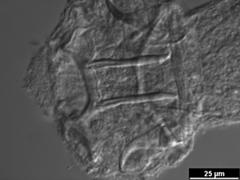Project 4221: Mare Geraerts, Tine Huyse, Maxwell Barson, Hassan Bassirou, Charles F. Bilong Bilong, Arnold R. Bitja Nyom, Auguste Chocha Manda, Armando J. Cruz-Laufer, Clément Kalombo Kabalika, Gyrhaiss Kapepula Kasembele, Fidel Muterezi Bukinga, Samuel Njom, Maarten Van Steenberge, Tom Artois, Maarten P. M. Vanhove. 2023. Sharing is caring? Barcoding suggests co-introduction of dactylogyrid monogeneans and transfer towards native tilapias induced by introducing Nile tilapia in sub-Saharan Africa. International Journal for Parasitology. XXX:1-20.
Abstract
Invasive Nile tilapias negatively impact native tilapia species through hybridisation and competition. However, the co-introduction of parasites with Nile tilapia, and subsequent changes in parasite communities, are scarcely documented. Monogeneans are known pathogens of cultured Nile tilapia, although little is known about their fate once Nile tilapias establish in new ecosystems. We investigate the parasitological consequences of Nile tilapia introduction on native tilapias in basins in Cameroon, the Democratic Republic of the Congo (DRC), and Zimbabwe, focusing on ectoparasitic dactylogyrids (Monogenea). Using the mitochondrial cytochrome oxidase c subunit I (COI) and nuclear 18S-internal transcribed spacer 1 (18S-ITS1) rDNA region of 128 and 166 worms, respectively, we evaluated transmission of several dactylogyrid species. Parasite spillover from Nile tilapia was detected for Cichlidogyrus tilapiae to Coptodon guineensis in Cameroon, Cichlidogyrus thurstonae to Oreochromis macrochir in the DRC, and Cichlidogyrus halli and C. tilapiae to Coptodon rendalli in Zimbabwe. Parasite spillback to Nile tilapia was detected for Cichlidogyrus papernastrema and Scutogyrus gravivaginus from Tilapia sparrmanii and Cichlidogyrus dossoui from C. rendalli or T. sparrmanii in the DRC, and Cichlidogyrus chloeae from Oreochromis cf. mortimeri and S. gravivaginus from O. macrochir in Zimbabwe. ‘Hidden’ transmissions (i.e. transmission of certain parasite lineages of species that are naturally present on both alien and native hosts) were detected for C. tilapiae and Scutogyrus longicornis between Nile tilapia and Oreochromis aureus and C. tilapiae between Nile tilapia and Oreochromis mweruensis in the DRC, and Cichlidogyrus sclerosus and C. tilapiae between Nile tilapia and O. cf. mortimeri in Zimbabwe. A high density of Nile tilapia occurring together with native tilapias, and the broad host range and/or environmental tolerance of the transmitted parasites, are proposed as factors behind parasite transmission through ecological fitting. However, continuous monitoring and the inclusion of environmental variables are necessary to understand the long-term consequences of these transmissions on native tilapias and to elucidate other underlying factors influencing these transmissions.Read the article »
Article DOI: 10.1016/j.ijpara.2023.05.007
Project DOI: 10.7934/P4221, http://dx.doi.org/10.7934/P4221
| This project contains |
|---|
Download Project SDD File |
Currently Viewing:
MorphoBank Project 4221
MorphoBank Project 4221
- Creation Date:
25 March 2022 - Publication Date:
29 October 2023
Authors' Institutions ![]()
- Royal Museum for Central Africa, Tervuren
- Hasselt University
- Katholieke Universiteit Leuven
- University of Antwerp
- Royal Belgian Institute of Natural Sciences
- University of Botswana
- University of Zimbabwe
- Centre de Recherche en Hydrobiologie, Uvira
- Université de Lubumbashi
- University of Douala
- Université de Yaoundé I
- University of Ngaoundéré
Members
| member name | taxa |
specimens |
media |
| Mare Geraerts Project Administrator | 175 | 176 | 1667 |

